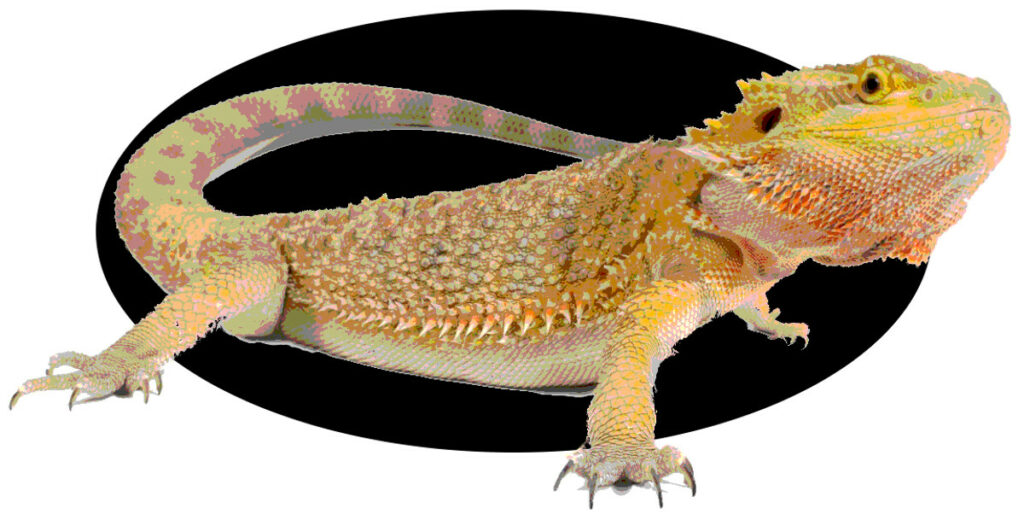Dragões barbudos são onívoros, o que significa que eles têm uma dieta variada composta por proteínas animais (principalmente insetos) e matéria vegetal. Uma alimentação equilibrada é essencial para a saúde.
Na natureza, bearded dragons have a varied diet that typically includes a combination of insects, small invertebrates, e matéria vegetal.
Their natural diet may consist of insects like crickets, gafanhotos, ants, besouros, and termites.
They also feed on vegetation such as leaves, flores, frutas, and even the occasional small vertebrate or rodent.
Wild bearded dragons are opportunistic feeders, meaning they eat what is available to them based on their location and seasonal changes in food availability.
Esta página contém links de afiliados. Como associados da Amazon, podemos ganhar uma comissão por compras de produtos qualificados. Isso não tem custos adicionais para você.
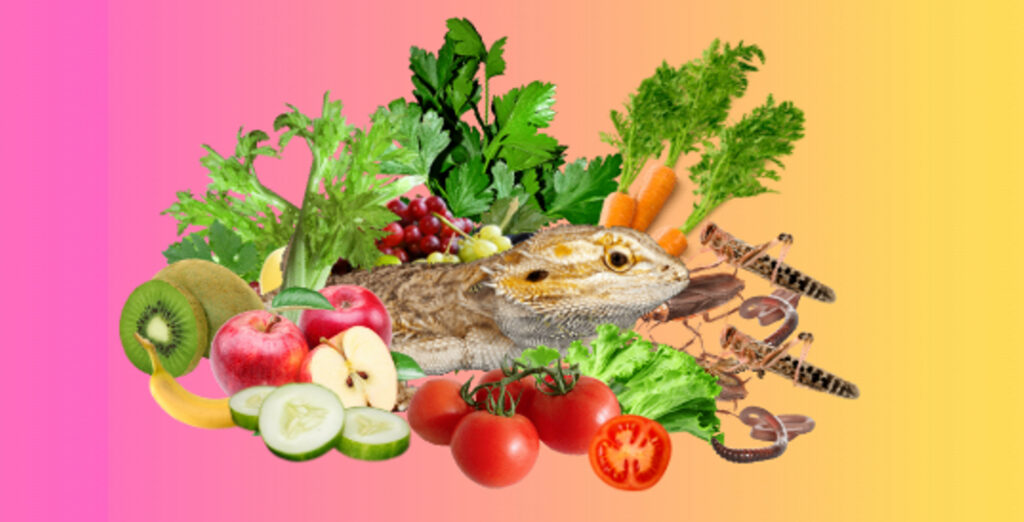
Como animais de estimação, bearded dragons should be fed a diet that is as close to their natural diet as possible.
This means feeding them a variety of insects, small invertebrates, e matéria vegetal.
Some good options for insects include crickets, larvas de farinha, baratas dubia, e bichos-da-seda.
Some good options for plant matter include collard greens, couve, cenouras, and sweet potatoes.
It is also important to dust the insects you feed your bearded dragon with calcium powder to help ensure they are getting enough calcium.
Recommended Diet and Feeding
A porcentagem de insetos e vegetais na dieta de um dragão barbudo deve variar dependendo da idade.
Adultos
Os adultos devem seguir uma dieta que seja 15% insetos e 85% verdes. Isso ocorre porque eles não precisam de tanta proteína quanto os filhotes e juvenis, e eles podem obter o cálcio que precisam dos seus vegetais.
As folhas verdes escuras ricas em ácidos graxos n3 são especialmente importantes para adultos, pois podem ajudar a reduzir a inflamação e melhorar a saúde geral.
Juvenis
Os juvenis devem seguir uma dieta que seja 15-30% verdes e 70-85% insetos. Isso ocorre porque eles ainda estão crescendo e se desenvolvendo, e eles precisam da proteína e do cálcio que os insetos fornecem.
É importante oferecer uma variedade de insetos aos juvenis, incluindo grilos, larvas de farinha, e baratas dubia.
| Idade | Insetos | Vegetais | Horário de alimentação |
|---|---|---|---|
| Filhotes (0-3 meses) | 85% | 15% | 4-5 vezes por dia |
| Juvenis (4-12 meses) | 70-80% | 20-30% | 2-3 vezes por dia |
| Adultos (1-7 anos) | 15-30% | 70-85% | 1-2 vezes por dia |
| Idosos (> 7 anos) | 15% | 85% | 1-2 vezes por dia |
Dragões barbudos filhotes e juvenis precisam de muitos insetos alimentadores para ajudá-los a crescer e se desenvolver.
Eles devem ser oferecidos tanto quanto comerão, 4-5 vezes por dia. À medida que crescem, eles começarão a depender menos de insetos e mais de verduras e vegetais.
Dragões barbudos adultos só precisam de apenas 15% insetos em sua dieta, e comerão com menos frequência à medida que envelhecem.
É uma boa ideia carregar insetos no intestino (alimente-os com alimentos nutritivos) e polvilhe-os com suplementos de cálcio e multivitamínicos para garantir que seu dragão receba nutrientes essenciais.
Feeder Insects
Here are some of the best feeder insects for bearded dragons:
| Insect | Proteína (%) | Gordo (%) | Cálcio (mg/kg) | Fósforo (mg/kg) |
|---|---|---|---|---|
| Baratas Dubia | 21.4 | 3.1 | 700 | 2600 |
| Goliath Worms | 9 | 3.07 | 464 | 1394 |
| Waxworms | 14.1 | 24.9 | 243 | 1650 |
| Supervermes | 19.7 | 17.7 | 177 | 2370 |
| Vermes da farinha | 18.7 | 13.4 | 169 | 2950 |
| Grilos | 15.4 | 3.3 | 275 | 2520 |
| Black Soldier Fly Larvae | 17.5 | 14 | 9340 | 3560 |
| Butterworms | 15.5 | 29.4 | 125 | 2250 |
| Silkworms | 9.3 | 1.1 | 177 | 2370 |
Baratas Dubia
Dubia roaches are a popular choice for bearded dragon owners because they are high in protein and calcium, low in fat, e fácil de cuidar.
They can be purchased online or at most pet stores.

Hornwarms / Goliath Worms
Hornwarms aka Goliath worms are another good option for bearded dragons.
They are high in moisture and nutrients, and they are also a good source of beta-carotene, which can help to improve the color of your dragon’s beard.

Waxworms
Waxworms are a high-fat insect, so they should only be fed as a treat.
No entanto, they are a good source of energy and can be helpful for dragons that are recovering from illness or surgery.

Supervermes
Superworms are similar to mealworms, but they are larger and have a softer exoskeleton.
This makes them easier for bearded dragons to digest.

Vermes da farinha
Mealworms are a good source of protein and calcium, but they can be hard for young bearded dragons to digest.
They should only be fed as part of a varied diet.

Grilos
Crickets are a common feeder insect, and they are a nutritious choice for bearded dragons which is very low in fat.
They are however not the easiest to keep, as and they can be noisy and messy.

Black Soldier Fly Larvae
Black soldier fly larvae are an excellent feeder insect for bearded dragons.
They have a high calcium content and are easy to gut-load.
They can be a bit more expensive than other feeder insects, but they are worth the investment.

Butterworms
Butterworms are another good option for bearded dragons.
They are high in protein and calcium, and they are also a good source of fat.
They can be a bit messy, but they are a popular choice for dragons.

Silkworms
Silkworms are not as common as other feeder insects, but they can be a good option for bearded dragons.
They are high in protein and calcium, and they are also a good source of fiber.
No entanto, they can be difficult to find and can be expensive.

Vegetables and fruit
The diet of an adult bearded dragon should consist of approximately 85% greens and vegetables. Vegetables are an important source of vitamins, minerais, e fibra para dragões barbudos. Dark leafy greens rich in n3 fatty acids should be the primary focus.
Here is a breakdown of the different types of vegetables that bearded dragons can eat:
Primary non-goitrogenic greens
These greens are low in oxalates and can be fed to your dragon every day. They are a good source of vitamins, minerais, e fibra.
Try to provide at least two different types of these greens and rotate them often.
- Dente-de-leão: Dandelion greens are a good source of vitamins A, C, e K, assim como cálcio e fibras. They are also a good source of antioxidants.
- Endive/escarole: Endive and escarole are similar greens that are also low in oxalates. They are a good source of vitamins A, C, e K, assim como cálcio e fibras.
- Alfalfa: Alfalfa sprouts are a good source of vitamins A, C, e K, assim como cálcio e fibras. No entanto, alfalfa sprouts can be high in phosphorus, so it is important to limit the amount that you feed your dragon.
- Arugula: Arugula is a good source of vitamins A, C, e K, assim como cálcio e fibras. Também é uma boa fonte de antioxidantes.
- Carrot tops: Carrot tops are a good source of vitamins A, C, e K, assim como cálcio e fibras. They are also a good source of antioxidants.
Primary goitrogenic greens
These greens are higher in oxalates, but they are still healthy for bearded dragons. You can feed them often as long as you rotate between these and non-goitrogenic greens.
- Couve: Collard greens are a good source of vitamins A, C, e K, assim como cálcio e fibras. They are also a good source of antioxidants.
- Mostarda verde: Mustard greens are a good source of vitamins A, C, e K, assim como cálcio e fibras. They are also a good source of antioxidants.
- Bok choy: Bok choy is a good source of vitamins A, C, e K, assim como cálcio e fibras. They are also a good source of antioxidants.
- Nabos: Turnip greens are a good source of vitamins A, C, e K, assim como cálcio e fibras. They are also a good source of antioxidants.
- Agrião: Watercress is a good source of vitamins A, C, e K, assim como cálcio e fibras. They are also a good source of antioxidants.
Secondary greens
These greens are safe to feed your dragon, but they are not as nutritious as the primary greens. You may feed these every other day, rotating between them.
- Couve-rábano: Kohlrabi is a good source of vitamins C and K, bem como fibra.
- Beet greens: Beet greens are a good source of vitamins A, C, e K, bem como fibra.
- Parsley: Parsley is a good source of vitamins A, C, e K, as well as iron and folate.
- Coentro: Cilantro is a good source of vitamins A, C, e K, as well as iron and folate.
- Alecrim: Rosemary is a good source of vitamins A and C, assim como antioxidantes.
- Manjericão: Basil is a good source of vitamins A and C, assim como antioxidantes.
Tertiary greens
These greens can be fed to your dragon, but they should be limited to once or twice a week, rotating often.
- Repolho: Cabbage is a good source of vitamins C and K, bem como fibra.
- Espargos: Asparagus is a good source of vitamins A, C, e K, bem como fibra.
- Folhas de aipo: Celery leaves are a good source of vitamins A and C, bem como fibra.
Occasional greens (use infrequently)
These greens, due to their high oxalate content, are best fed sparingly.
- acelga: This leafy green is a source of vitamins A, C, K, cálcio, e fibra. No entanto, due to elevated oxalates, it’s recommended to include it in your dragon’s diet once or twice a week.
- Couve: Another leafy green rich in vitamins A, C, K, cálcio, e fibra. Nevertheless, it has higher oxalate levels, so it’s advisable to limit it to once or twice a week in your dragon’s diet.
- Espinafre: Among leafy greens, spinach is known for its abundant vitamins A, C, K, cálcio, e fibra. No entanto, it contains very high oxalate levels, so use it sparingly.
- Strawberry tops: These are the leaves from strawberry plants, offering vitamins A and C, along with fiber. No entanto, they also contain some oxalates. It’s recommended to offer them to your dragon once or twice a week.
- Wheatgrass: This young grass is a good source of vitamins A, C, e K, cálcio, e fibra. Nevertheless, it contains some oxalates. Portanto, it’s best to feed it to your dragon once or twice a week.
- Borage greens: Borage greens are leafy vegetables rich in vitamins A and C and packed with antioxidants. No entanto, they do contain some oxalates. Como resultado, it’s suggested to incorporate them into your dragon’s diet once or twice a week.
- Mulberry leaves: These leaves from mulberry trees offer vitamins A and C and provide antioxidants. They also contain some oxalates. For this reason, it’s advisable to include them in your dragon’s diet once or twice a week.
Frequent vegetables
These vegetables, with their lower oxalate content, can be included more regularly in your dragon’s diet.
- Yellow/summer squash: This variety of squash is abundant in vitamins A and C, potássio, e fibra. It’s also a rich source of beta-carotene, an important antioxidant for eye health.
- Green squash/zucchini: This type of squash is rich in vitamins A and C, potássio, e fibra. It’s also a great source of beta-carotene, a vital antioxidant for eye health.
- Sweet potato: As a root vegetable, sweet potato offers vitamins A and C, potássio, e fibra. It’s also packed with beta-carotene, a crucial antioxidant for maintaining eye health.
- Yam: Another root vegetable, yam provides vitamins A and C, potássio, e fibra. It’s also abundant in beta-carotene, an antioxidant that supports eye health.
- Prickly pear pads: These pads from prickly pear cacti supply vitamins A and C, cálcio, e fibra. They also boast antioxidants.
- Abóbora: This type of squash is rich in vitamins A and C, potássio, e fibra. It’s also packed with beta-carotene, an essential antioxidant for eye health.
- Abóbora: Butternut squash provides vitamins A and C, potássio, e fibra. It’s also a significant source of beta-carotene, an antioxidant important for eye health.
- Hubbard squash: Hubbard squash is abundant in vitamins A and C, potássio, e fibra. It’s also a great source of beta-carotene, a crucial antioxidant for eye health.
- Espaguete de abóbora: This variety of squash offers vitamins A and C, potássio, e fibra. It’s also packed with beta-carotene, an antioxidant that supports eye health.
- Chayote squash: This type of squash provides vitamins A and C, potássio, e fibra. It’s also a source of antioxidants.
- pimentões: Bell peppers are a good source of vitamins A and C, potássio, e fibra. They are also rich in antioxidants.
- Vagem: These beans are a good source of vitamins A and C, potássio, fibra, e antioxidantes.
Less frequent vegetables
These vegetables are safe for your dragon but should be fed less often than the frequent vegetables.
- Cenouras: This root vegetable is a good source of vitamins A and C, as well as potassium and fiber. It’s also rich in beta-carotene, an antioxidant important for eye health.
- Parsnips: Another root vegetable, parsnips provide vitamins A and C, as well as potassium and fiber.
- Okra: This vegetable is a good source of vitamins C and K, bem como fibra.
- Cucumbers: A vegetable with vitamins C and K and notable for its high water content.
- Peas: These legumes offer vitamins A and C, along with protein and fiber.
- Corn: A grain rich in vitamins A and C, bem como fibra.
- Beets: This root vegetable provides vitamins A and C, potássio, e fibra.
- Turnips: Another root vegetable, turnips are rich in vitamins A and C, potássio, e fibra.
- Abóbora: A winter squash offering vitamins A and C, potássio, e fibra.
- Radishes: These root vegetables are a good source of vitamins C and K, along with fiber.
- Daikon radishes: Providing vitamins C and K, bem como fibra.
- Artichoke hearts: These are a source of vitamins C and K, fibra, e antioxidantes.
- Kidney beans: Legumes that offer protein, fibra, e vitaminas A e C.
- Lima beans: Providing protein, fibra, e vitaminas A e C.
- Pinto beans: These legumes offer protein, fibra, e vitaminas A e C.
- Garbanzo beans: Legumes that provide protein, fibra, e vitaminas A e C.
- Raiz de mandioca: This root vegetable is a good source of vitamins C and K, bem como fibra.
- Rutabaga: Another root vegetable, rutabaga is rich in vitamins C and K, along with fiber.
Frutas
Fruits can be fed to your dragon as an occasional treat. Most fruits have moderate to high levels of sugar and overfeeding can cause to obesity and other health issues, então moderação é a chave.
- Morangos: These berries are rich in vitamins C and K and provide fiber. They are relatively low in sugar, making them a suitable choice for regular, but not excessive, consumption.
- Amoras: Blueberries are packed with vitamins C and K and antioxidants. They have moderate sugar levels, então eles devem ser alimentados com moderação.
- Framboesas: These fruits provide vitamins C and K and are a good source of fiber. They are relatively low in sugar, making them suitable for occasional consumption.
- Cantalupo: This melon offers vitamins A and C, as well as potassium. It contains moderate sugar levels, so it should be fed sparingly.
- Pêssegos: Peaches are rich in vitamins A and C and provide potassium. They have moderate sugar levels and should be given sparingly.
- Peras: Pears are a source of vitamins A and C, along with fiber. They are relatively low in sugar and can be included in your dragon’s diet occasionally.
- Amora silvestre: These berries are rich in vitamins C and K and fiber. They are relatively low in sugar, making them a suitable choice for regular, but not excessive, consumption.
- Banana: While they provide potassium and vitamin C, bananas have higher sugar levels compared to some other fruits. Offer them sporadically and in smaller quantities.
- Pomegranate: This fruit is known for its antioxidants. It has moderate sugar levels, so it should be fed in moderation.
- Mamão: Providing vitamins C and A, as well as potassium, papayas contain moderate sugar levels. They should be given sparingly.
- Melada: This melon offers vitamins A and C, as well as potassium. It contains moderate sugar levels, so it should be fed sparingly.
- Apple: Apples provide vitamins A and C, along with fiber. They have moderate sugar levels, so they can be included in your dragon’s diet occasionally.
- Apricot: These fruits offer vitamins A and C, as well as potassium. They have moderate sugar levels, making them suitable for occasional consumption.
Foods to Avoid
- Citrus Fruits: Citrus fruits like oranges, limões, and grapefruits are too acidic for bearded dragons and can upset their digestive system.
- Abacate: Avocado contains substances that are toxic to many animals, including bearded dragons. Avoid feeding any part of the avocado.
- Rhubarb: Rhubarb leaves and stems contain oxalates and other compounds that are toxic to bearded dragons. Do not include rhubarb in their diet.
Opções Reptilink para dragões barbudos
Reptilinks são um tipo de dieta de presas inteiras para répteis, que vêm na forma de pré-embalados, links de “salsicha” congelada.
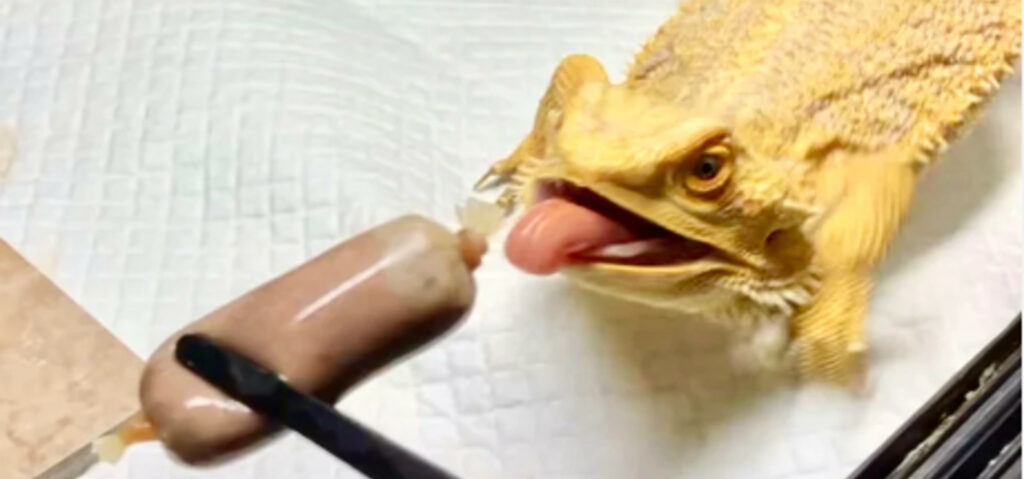
Existem duas misturas principais de reptilinks que são especialmente formuladas para dragões barbudos adultos e subadultos.:
- 50/50 Mistura onívora: Coelho (Ohio criou raça branca da Nova Zelândia ou raça branca da Califórnia, inclui carcaça inteira), feijão verde orgânico, couve, dente-de-leão verde, endívia, 100% invólucro de colágeno natural.
- 25/25/50 Mistura onívora + Insetos: Insetos (baratas sibilantes, grilos, supervermes), coelho (Ohio criou raça branca da Nova Zelândia ou raça branca da Califórnia, inclui carcaça inteira), feijão verde orgânico, couve, dente-de-leão verde, endívia, 100% invólucro de colágeno natural.
Você pode pegar $5 desconto no seu próximo pedido de Reptilinks usando o código ‘petswithscales’ na finalização da compra ou fazendo o pedido através do nosso link promocional.

Coisas a considerar
To ensure a healthy diet for your bearded dragon, keep the following considerations in mind:
- Moderation and Rotation: Moderation is crucial to maintain a balanced diet. Rotate the greens and vegetables to prevent overconsumption of specific compounds and ensure a varied nutrient intake.
- Goitrogenic and Oxalate Content: Be cautious with goitrogenic vegetables like kale, brócolis, e couve-flor, as well as high-oxalate foods like spinach and carrots. These should not be staple foods and should be fed in moderation or avoided altogether.
- Avoid Store-Bought Pelleted Food: Store-bought pelleted food is highly processed and lacks the necessary nutritional value and may contain “filler” foods like rice, soy or grains which are not ideal for bearded dragons. If you are looking for alternatives to feeding insects, reptilinks is your best choice.
- Phosphorus Consideration: Excessive phosphorus can hinder calcium absorption. Opt for foods low in phosphorus to ensure proper nutrient balance.
- Suplementos. Bearded dragons need lots of calcium and their food should be dusted with calcium supplements and reptile multivitamins to ensure they get all the nutrition they need.
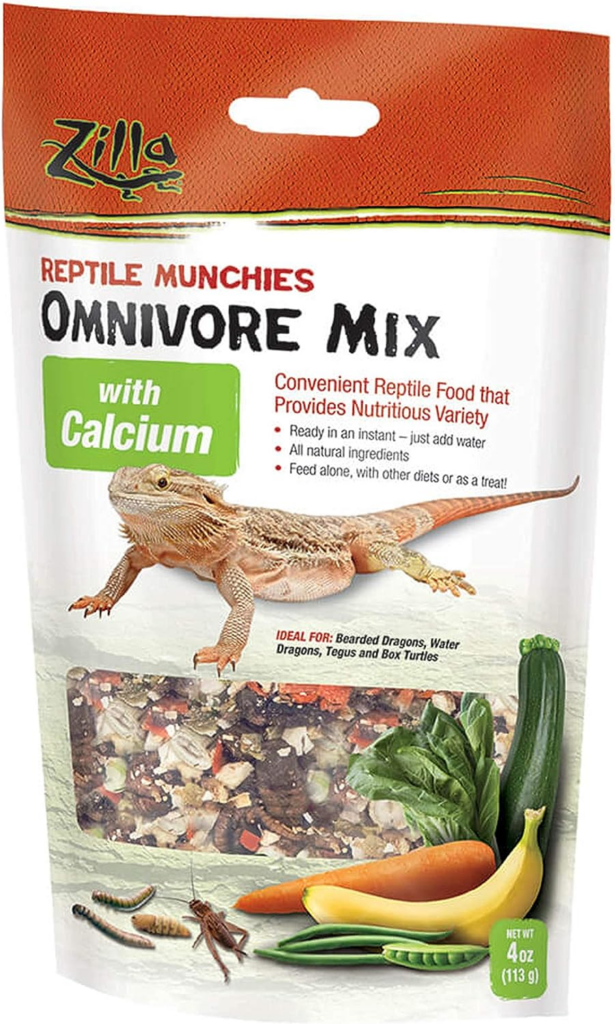 Zilla Omnivore Mix – Insetos, Frutas e Vegetais + Cálcio | 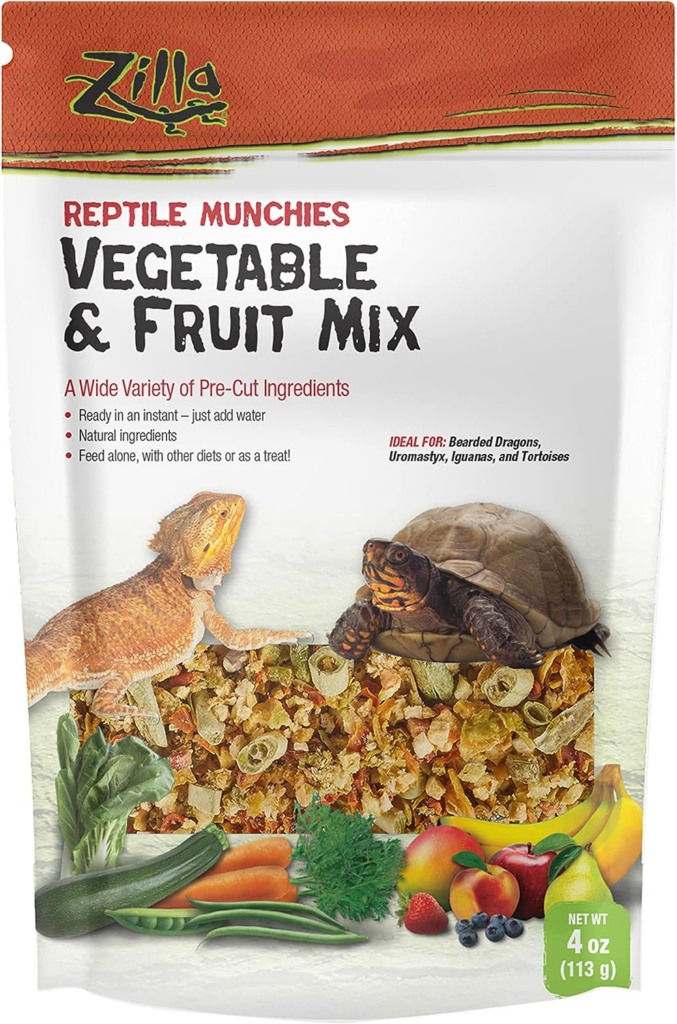 Mistura de vegetais e frutas Zilla | 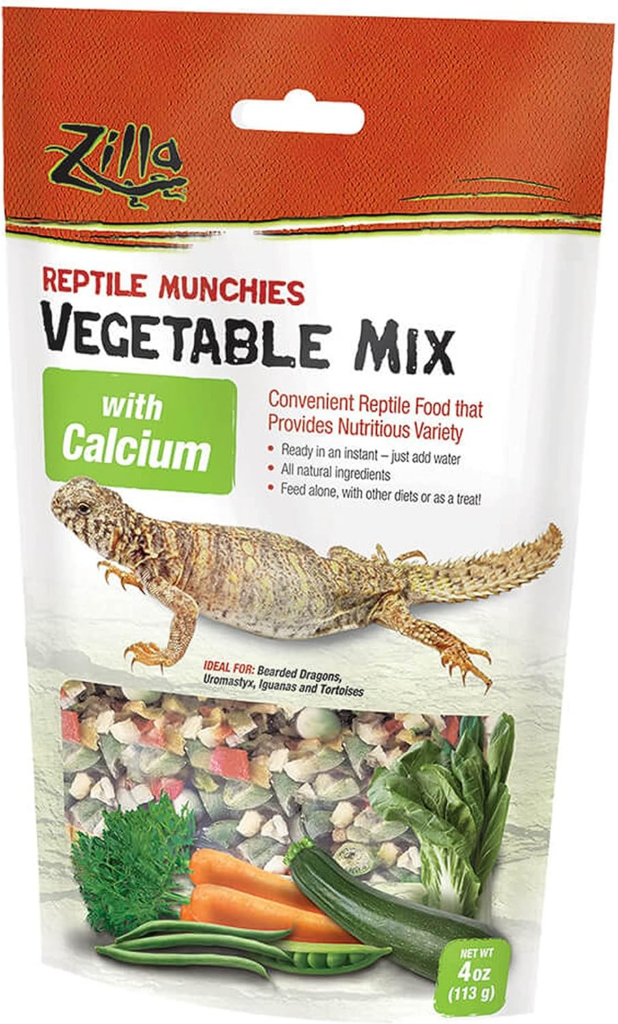 Mistura de vegetais Zilla + Cálcio |
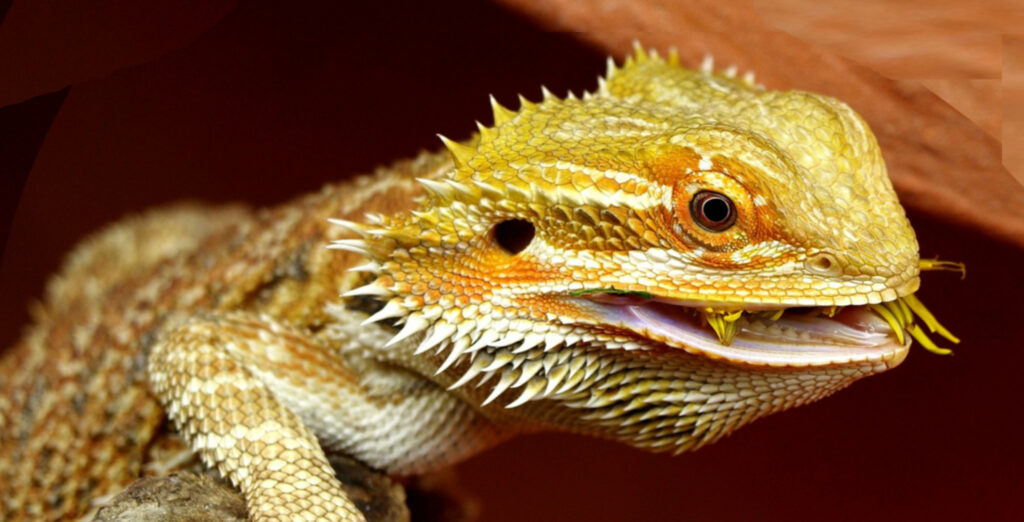
Bearded Dragon Diet FAQs
What should I feed my bearded dragon, and how often?
Your bearded dragon’s diet should consist of a balance of greens and insects.
For adult dragons, focus on 85% verdes e 15% insetos, while juveniles should have 70-85% insects and the rest greens.
This ensures they get the nutrients they need at different stages of life.
What are the best feeder insects for bearded dragons?
The best feeder insects for bearded dragons are those that are high in protein and calcium, and low in fat. Some of the best options include:
- baratas Dubia
- Black soldier fly larvae
- Silkworms
- Vermes da farinha
- Supervermes
- Waxworms
It is important to choose a variety of feeder insects to ensure that your bearded dragon is getting all the nutrients it needs.
What is gut-loading and why is it important for bearded dragons?
Gut-loading is the process of feeding feeder insects nutritious food before you feed them to your bearded dragon.
This helps to ensure that your dragon is getting the nutrients it needs from the insects.
You can gut-load feeder insects with fruits, vegetais, verdes, and even calcium powder.
Gut-loading is important for bearded dragons because they are not able to digest all of the nutrients in insects on their own.
By gut-loading the insects, you are providing them with the nutrients they need to stay healthy.
How many insects do baby bearded dragons need?
Baby bearded dragons need to eat a lot of insects to grow and develop properly. They should be fed insects 3-4 vezes por dia, and the amount of insects you feed them will depend on their age and size.
A good rule of thumb is to feed baby bearded dragons as many insects as they can eat in 15 minutos.
As they get older, you can gradually decrease the number of insects you feed them.
Why is it important to choose the right greens for my beardie?
Selecting the right greens is crucial as an improper diet can lead to health problems.
Bearded dragons can develop cholelithiasis (gallbladder problems) from an unbalanced diet.
It’s vital to provide a balanced, plant-based diet to prevent such issues.
Which vegetables should I be cautious about feeding my bearded dragon?
Exercise caution with cruciferous vegetables like kale, brócolis, and Brussels sprouts.
These can interfere with thyroid function due to their goitrogenic compounds. Avoid overfeeding these greens to prevent potential health issues.
What about oxalates in vegetables? Are they harmful to my dragon?
Oxalic acid in certain plants, such as spinach and kale, can inhibit calcium absorption.
While specific limits for bearded dragons are uncertain, it’s best to keep soluble oxalate intake below 0.5% of their diet to ensure calcium absorption.
Why should I avoid store-bought pelleted food for my dragon?
Store-bought pelleted food lacks essential nutrients and is akin to fast food for dragons.
Bearded dragons thrive on a diet that includes live prey for stimulation and proper nutrition, replicating their natural feeding habits.
Is it okay to feed “spring mix” or “power greens” from the store?
While “spring mix” and “power greens” can be used occasionally, they often contain low-nutrient lettuces and spinach.
Avoid making these mixes a staple in your dragon’s diet to ensure they receive a well-rounded nutrition.
What should I include in my dragon’s diet?
Ensure variety in your dragon’s diet by including non-goitrogenic greens (e.g., dente-de-leão verde, endívia), goitrogenic greens (e.g., couve, mostarda verde), and other vegetables (e.g., abóbora, sweet potato).
Rotate these options for a balanced diet.
What fruits can I feed my bearded dragon?
Offer occasional fruits like strawberries, amoras, and melons as treats.
Avoid citrus fruits as they can be harmful to your dragon’s health.
Is cooking necessary for vegetables and greens?
There’s no need to cook vegetables for your beardie. Simply cut them into smaller, manageable pieces for easy consumption.
Cooking may be necessary if your dragon is unwell or having difficulty eating.
LINKS RÁPIDOS DO DRAGÃO BARBUDO
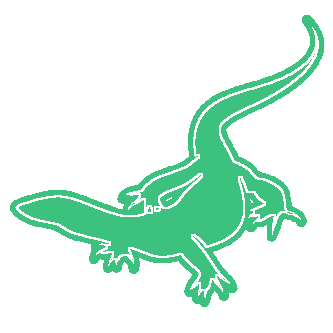
PetsWithScales.com é um site informativo sobre cuidados com animais de estimação de grandes lagartos. Coletamos e fornecemos informações de diferentes fontes na web sobre como manter e cuidar de répteis como animais de estimação. As espécies com as quais lidamos principalmente são os tegus, lagartos monitores, lagartos e lagartixas. Nosso objetivo é fornecer informações de alta qualidade para ajudar os donos de animais de estimação a, decisões mais informadas sobre as dietas de seus animais, saude e vida.

PetsWithScales.com é um site informativo sobre cuidados com animais de estimação de grandes lagartos. Coletamos e fornecemos informações de diferentes fontes na web sobre como manter e cuidar de répteis como animais de estimação. As espécies com as quais lidamos principalmente são os tegus, lagartos monitores, lagartos e lagartixas. Nosso objetivo é fornecer informações de alta qualidade para ajudar os donos de animais de estimação a, decisões mais informadas sobre as dietas de seus animais, saude e vida.
